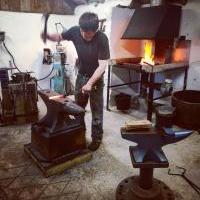-
Posts
9 -
Joined
-
Last visited
Contact Methods
-
Website URL
http://ornamentalroseengine.com/smith/hammer
Profile Information
-
Gender
Male
-
Location
Cabarrus County, North Carolina, USA
Recent Profile Visitors
1,474 profile views
-
I solved the issue o my power hammer walking across the concrete. In the hast of wanting to try out my new hammer, I never installed the braces between the anvil and the post. I installed the braces yesterday and it made the machine much more solid and it appears it is not moving at all. I think I'm completely finished with the power hammer. Power hammer photos and notes, http://ornamentalros...om/smith/hammer
- 20 replies
-
- tire hammer
- clutch
-
(and 1 more)
Tagged with:
-
I'm planning to upload a video when I figure out the whole process. It doesn't seem like this site allows uploading of video files. This 1000 pound total weight mechanical power hammer with a 660 pound anvil bolted to the 136 pound piece of steel base plate is slowly walking on the slightly sloping [1/4" per foot] concrete floor. The 660 pound anvil is 18.9 times the 35 pound hammer weight. I think at least 20 times is a good ratio. I've been updating my power hammer photos and notes at http://ornamentalroseengine.com/smith/hammer Fred
- 20 replies
-
- tire hammer
- clutch
-
(and 1 more)
Tagged with:
-
basher, The brake and clutch lining friction material I used has the lowest coefficient of friction [0.14] of the several choices at McMaster-Carr [the highest offered is 0.55]. I do not know what the material is made of. It sure does work nicely. I would not want a higher coefficient of friction and may not want any more friction material contact area. McMaster suggested the low coefficient of friction for "smooth stops" [brakes] and the high coefficient of friction sheets "provide immediate engagement". I think a little more rotating mass would be desirable. But, if you have much more rotating mass then stopping the hammer becomes an issue and some sort of brake would be desirable. Fred
- 20 replies
-
- tire hammer
- clutch
-
(and 1 more)
Tagged with:
-
The die is a 1.5"x1.5"x3" piece of 4140 welded to a 4"x"4x1" piece of hot rolled steel. I heated up the die and welded it to the plate with "Missile Rod". Then I heated the die & plate to cherry red and let it cool slowly in the propane forge to stress relieve it. I have not yet hardened the die.
- 20 replies
-
- tire hammer
- clutch
-
(and 1 more)
Tagged with:
-
Frosty - I drilled and threaded a 16"x30"x1" plate for the anvil base. It sits on a piece of rubber horse stall mat. So far it is not walking on the concrete. I'm a little surprised, since I have about 1/4" per foot slope on the concrete.
- 20 replies
-
- tire hammer
- clutch
-
(and 1 more)
Tagged with:
-
Peacock - One of the watchers of this project has been pressing me to rivit on brake pads just like you suggest. Since the clutch plate was the last operation, I decided to utilize the friction material with as little effort as possible. I think I could still cut up the piece and rivit it on. If it keeps working as nicely as it has so far, I don't think I'll mess with it. Originally, I was planning to put a brake on it but never worked the detail out. I even faced off the front side of the rotor that is fastened to the crankshaft. Even though, the brake rotor assembly is pretty heavy, the machine doesn't have enough flywheel effect to keep turning when the clutch is disengaged like a tire hammer does. When I let off the clutch it stops. This may be more of an issue if I speed the power hammer up.
- 20 replies
-
- tire hammer
- clutch
-
(and 1 more)
Tagged with:
-
Ray Clontz has used an automotive clutch on his personal power hammer since he built it in the early 2000's. Initially, he had to rework the clutch hub to fit the 1-3/8" crankshaft. I think he sprays his with WD-40 to get the performance he wants. I looked for an auto clutch plate that would fit my brake rotors until I ran across the friction material and realized I didn't need the hub of an automotive clutch. I drilled a 1-3/8" hole in the middle of the friction material with an old Forstner bit. I was planning to glue a bronze bushing in the friction material and may yet do that. I don't really like the friction material rotating directly on the crankshaft. I think auto clutch friction material has a good bit higher coefficient of friction than the piece I used. The clutch on my machine is very smooth. I cannot tell from foot pressure alone exactly at what point it fully engages, only by the frequency of hits. The disk rotors are 10.8" diameter with a little over 2" of friction surface. I am using a 7.5"x7.5"x3/8" piece of low coefficient of friction material between them. The diagonals of the square of the friction material just reach the edge of the disk rotors. I am curious what the effect would be to use a full 10.8" diameter piece between the rotors. It would more than double the friction surface area. If it halved the foot petal pressure to engage, then it would only take 10 pounds of foot pressure to engage. It would be a little more complicated to route the clutch linkage to reduce the foot petal leverage if that turned out too light. At some point, I may spring for the $70 for a piece of friction material big enough to get a full 10.8" diameter. I'll take a video in the next day or so of the hammer in action and post it.
- 20 replies
-
- tire hammer
- clutch
-
(and 1 more)
Tagged with:
-
After a lot of work, I have completed my mechanical power hammer. This is how I wanted to construct my power hammer, very adjustable. The most unique feature is the clutch mechanism. It consists of two automotive brake rotors. One is fastened to the crankshaft and the other is driven by the motor and free to rotate on the crankshaft. Between the two brake rotors is a 3/8" thick piece of clutch friction material. The footpetal force is transfered through a clutch linkage to a Chevy small block V-8 throw-out bearing that pushes the rotors together. I credit Ray Clontz [designer of the Tire Hammer] for encouraging me to build a power hammer instead of a treadle hammer. The auto rotor clutch system is inspired by Ray's own personal power hammer. The brake rotor disk clutch works very smoothly. For those interested, I have hastily posted some photogrphs and notes on my website. I am running the machine at a maximum 2.6 impacts per second until I am more comfortable operating it at a faster speed. A power hammer radically improved my blacksmithing experience. I can't guess how many more times it moves hot metal than I can by hand. Fred
- 20 replies
-
- tire hammer
- clutch
-
(and 1 more)
Tagged with:


